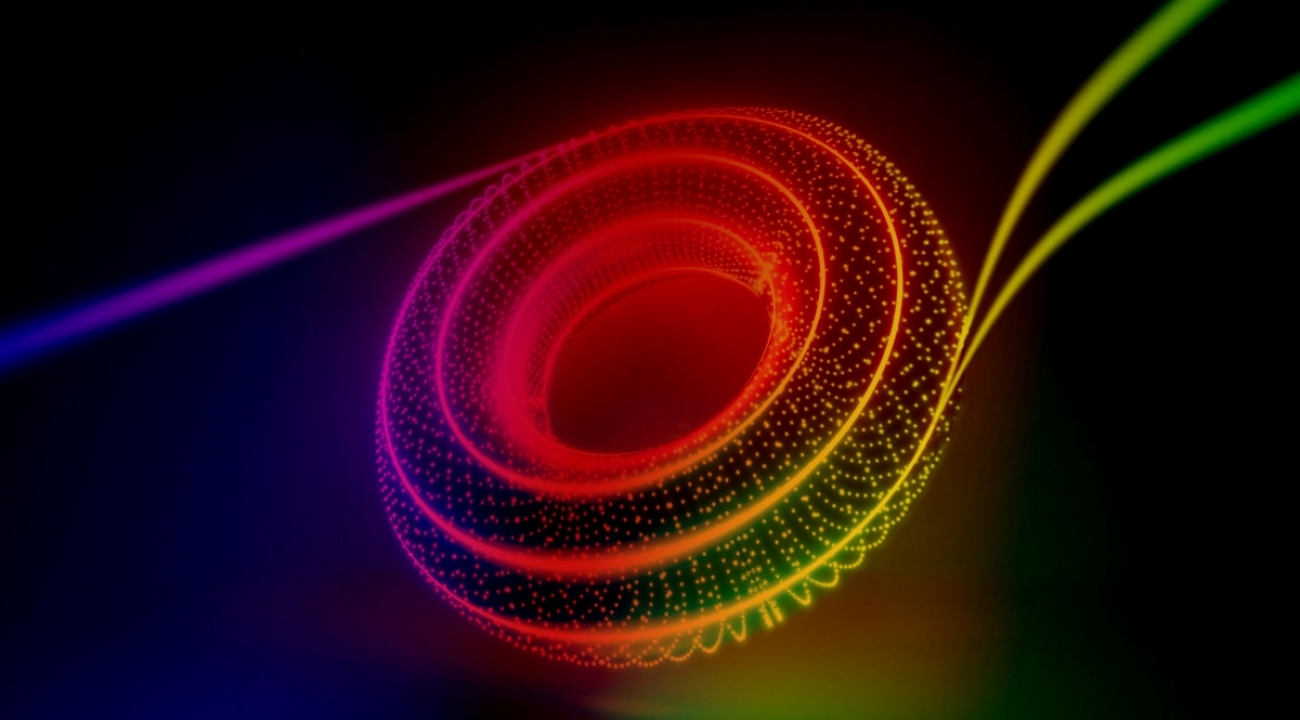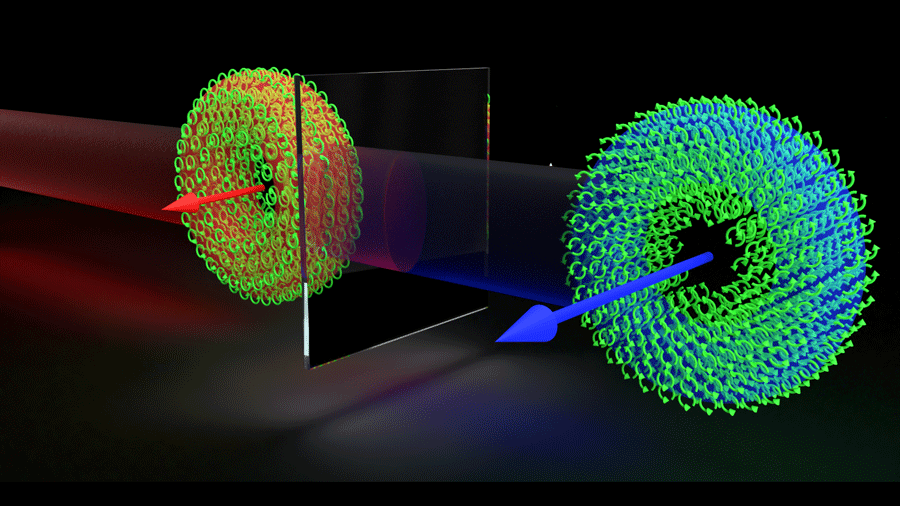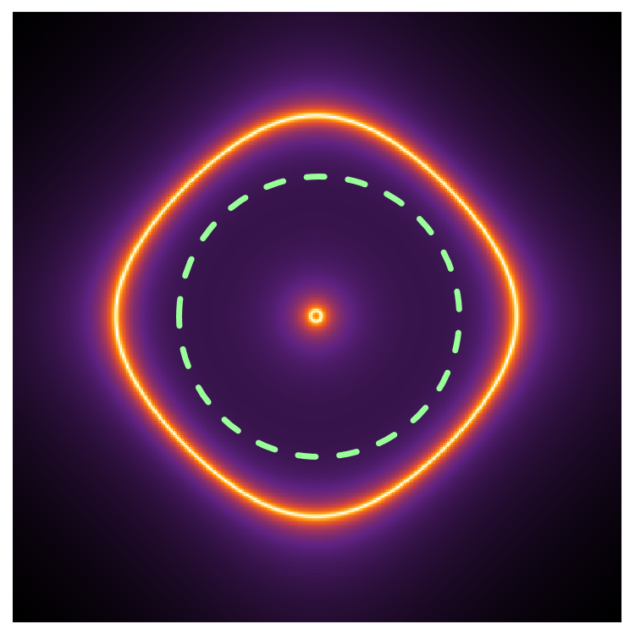- Details
-
Published: Tuesday, April 27 2021 05:33
Photons—the quantum particles of light—normally don’t have any sense of personal space. A laser crams tons of photons into a tight beam, and they couldn’t care less that they are packed on top of each other. Two beams can even pass through each other without noticing. This is all well and good when making an extravagant laser light show or using a laser level to hang a picture frame straight, but for researchers looking to develop quantum technologies that require precise control over just one or two photons, this lack of interaction often makes life difficult.
Now, a group of UMD researchers has come together to create tailored interactions between photons in an experiment where, at least for photons, two’s company but three’s a crowd. The technique builds on many previous experiments that use atoms as intermediaries to form connections between photons that are akin to the bonds between protons, electrons and other kinds of matter. These interactions, along with the ability to control them, promises new opportunities for researchers to study the physics of exotic interactions and develop light-based quantum technologies.
“With a laser you cannot really say ‘I only want one photon or two photons or three photons,’ or ‘I only want one and two photons, but not three photons,’” says Dalia Ornelas-Huerta, (Ph.D., '20) the lead experimental author on the paper. “So, with the system, it could lead to a degree of freedom of saying, ‘I want one photon or two photons, but not three.’”
In a paper published today in the journal Physical Review Letters(link is external), the researchers described how they created a venue for influencing a beam of photons, with several experimental knobs for adjusting the subtle interactions between them. In their experiment, they dialed up the interactions among three photons to be stronger than the interactions between two photons—a fact that allowed them to selectively remove three photons at a time from the beam. When they sent in a beam of light that generally contains no more than three photons, they got out just one or two photons at a time.
The effort to keep photons from congregating brought together several research groups at the University of Maryland (UMD). Ornelas-Huerta, Physics professor Steven Rolston--a Fellow of the Joint Quantum Institute and Quantum Technology Center--and JQI Fellow and NIST physicist Trey Porto, together with other team members, carried out the experiment. Adjunct faculty Alexey Gorhkov and Michael Gullans, both NIST physicists and Fellows of the Joint Center for Quantum Information and Computer Science, and colleagues focused on the theoretical explanation.
“We thought we had a simple idea,” says Gullans, who began working on this line of research in 2017 when he was a JQI postdoctoral researcher. “And then we tried the experiment. And we had to invent a bunch of new ideas for how to calculate three-body physics and we also spent a huge amount of time learning how to analyze the data and interpret the data to see evidence for this effect.”
That seemingly simple idea was to use Rydberg atoms as an intermediary between the normally non-communicative photons to create just the right conditions so that three photons traveling together would experience an interaction that would knock them out of the beam. These atoms are useful because they are sensitive to the influence of nearby photons and other atoms. The sensitivity arises because Rydberg atoms have electrons that roam far from the center of the atom, leaving them open to external influences—influences that can produce strong, adjustable interactions.
The interactions between the Rydberg atoms and a passing photon can form a polariton—a hybrid of the quantum states of the photon and the atoms that behaves like a new distinct particle. Polaritons have been used in many past experiments, and researchers know how to manipulate them (and their component photons) using lasers. The ability to manipulate these states inspired the researchers to try to craft a new sort of interaction where three polaritons interact in a distinctly different way than just two.
These sorts of interactions, called three-body interactions, aren’t very common in day-to-day life or even in a physics lab. Most interactions that happen at a scale bigger than an atom (no matter how many objects are involved) are two-body interactions, like the gravitational attraction between planets or the repulsion of electrons in a conductor. Being a two-body interactions simply means that the interactions between each possible pairing of objects is the same as if that pair existed in isolation. So the overall behavior of the collection is just the result of adding together the interactions between the pairs.
But in certain situations, like protons and neutrons binding together into atomic nuclei, three-body interactions occur and the total interaction is more than just the sum of interactions between pairs. These more complex relationships can arise when the particles that mediate the interaction (in nuclei, these particles are called gluons) can impact each other. So photons communicating through intermediary atoms have the potential for strong three-body interactions since the atoms can interact with each other and can change during the process.
“You have a feedback in the sense that the involved polaritons change because of the interaction,” says JQI postdoctoral researcher Przemyslaw Bienias, who was the theoretical lead author on the paper. So, you not only get an interaction but the interaction changes the polaritons' internal structure and this leads to those strong multi-body effects.”
You can think of the collection of Rydberg atoms in the experiment like a restaurant set up for Valentine’s Day with only intimate tables for two. Photons entering as couple or a single customer can happily enjoy a meal at a small, cozy table, but if you crowd three people around one, they are probably going to bump elbows and irritate each other. They will probably quickly leave the restaurant before getting to dessert.
For the photons (dressed up as polaritons), this change to the venue isn’t really about the physical space they share but about the abstract quantum space in which they exchange energy and momentum. In the abstract space, two photons can easily share a table without knocking each other into new states, but three will most likely elbow each other into new states and away from the table through an interaction.
The experiment’s success lies in the team determining how to orchestrate the necessary relationships between polaritons. They had to set the laser used to manipulate the atoms to a precise frequency, related to how the Rydberg atoms shuffle energy between quantum energy states that the outermost electron can inhabit. The team successfully created conditions where the possible interactions depended on the number of polaritons present. Just one or two and they were unlikely to scatter. But if three were available to exchange energy and momentum the chance of them interacting and being knocked out of the beam shot up. So after leaving the Rydberg atoms behind, the uncluttered stream of light is left containing just individual or pairs of photons.
The whole thing is the result of a carefully choreographed juggling act, with the atoms using energy from photons to move their electrons between low-, intermediate- and high-energy quantum states—all while simultaneously dancing with each other.
“It was challenging, both in theory and experiment,” Ornelas-Huerta says. “We needed to go into this experimental regime where we had strong interactions and we had a strong coupling between the light and the atoms and also we have to try to minimize the losses from the intermediate state.”
The theorists identified what laser frequencies to use and the signatures of three-photon losses that experimentalists looked for. Then they were able to closely match the experimental data to mathematical descriptions of how the interactions affected the photons traveling in bunches of various sizes and how the polaritons states exchanged energy and momentum during the interactions.
“There are still efforts in theory and experiment to keep studying different regimes of few-body interactions.” Ornelas-Huerta says. “And to study how we can tune them or how we can add other states to even have more degrees of freedom and make these interactions more tunable. There's still room to do much more research and interesting experiments on these systems.”
Understanding and being able to create many-body interactions opens opportunities to simulate the physics of other many-body interactions and to develop new technologies, like photonic gates that serve as the basic building blocks of quantum computers and quantum networks that can send messages between quantum devices.
“We now have a much clearer picture of the few-body physics in these Rydberg systems,” Gullans says. “And, I think where we want to go now is starting to put the pieces together—making photonic gates and quantum networks. We understand the fundamental physics well enough that we can start to get into those questions.”
Story by Bailey Bedford
In addition to Rolston, Porto, Gullans, Gorshkov, Ornelas-Huerta and Bienias, co-authors of the research paper include JQI graduate students Alexander Craddock and Andrew Hachtel; JQI postdoctoral researcher Mary E. Lyon; and JQI undergraduate summer researcher Marcin Kalinowski.
"Tunable Three-Body Loss in a Nonlinear Rydberg Medium," D. P. Ornelas-Huerta, Przemyslaw Bienias, Alexander N. Craddock, Michael J. Gullans, Andrew J. Hachtel, Marcin Kalinowski, Mary E. Lyon, Alexey V. Gorshkov, S. L. Rolston, J. V. Porto, Phys. Rev. Lett., 126, 173401 (2021) Original story: https://jqi.umd.edu/news/two-photons-company-threes-crowd
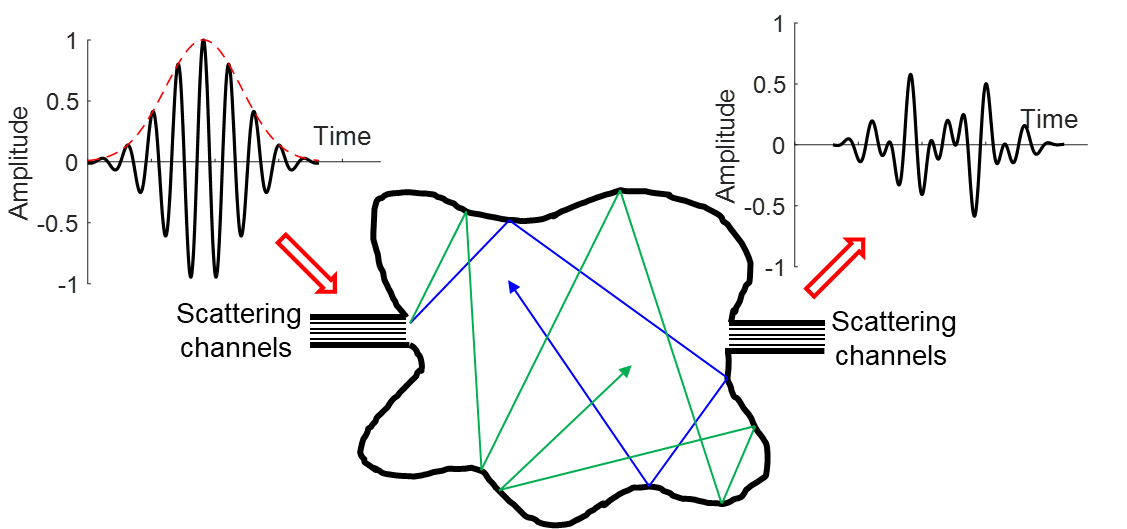 Schematic of time delay for scattering of a wave packet from a real-life ray-chaotic billiard. The symmetric and smooth wave packet goes in to the scattering region through one scattering channel and emerges later from another channel as a delayed and strongly distorted pulse. The complex time delay accounts for these changes.
Schematic of time delay for scattering of a wave packet from a real-life ray-chaotic billiard. The symmetric and smooth wave packet goes in to the scattering region through one scattering channel and emerges later from another channel as a delayed and strongly distorted pulse. The complex time delay accounts for these changes.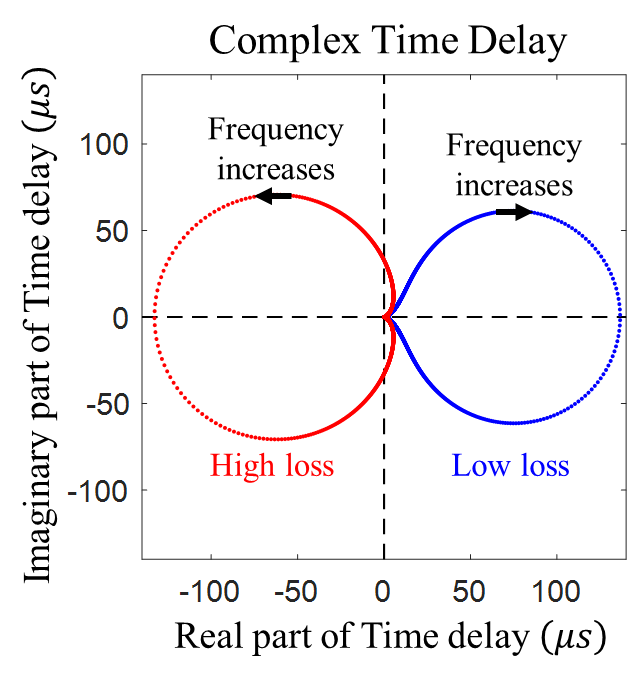 Illustration of complex time delay associated with a single resonant mode of a complex scattering system known as a quantum graph. Shown is the evolution of the complex time delay as a function of frequency near the resonance, illustrating how the real and imaginary parts of the time delay form a closed figure in the complex time-delay plane. The cases of two resonances, one with small loss and another with large loss, are shown for illustration. These results are from a simulation of the quantum graph. and Yan V. Fyodorov describe having generalized this time delay to real-world situations where there is dissipation and de-phasing, and created a very useful complex version of time delay. This generalized time delay has a real part that can be positive or negative, and an imaginary part, which can also have either sign.
Illustration of complex time delay associated with a single resonant mode of a complex scattering system known as a quantum graph. Shown is the evolution of the complex time delay as a function of frequency near the resonance, illustrating how the real and imaginary parts of the time delay form a closed figure in the complex time-delay plane. The cases of two resonances, one with small loss and another with large loss, are shown for illustration. These results are from a simulation of the quantum graph. and Yan V. Fyodorov describe having generalized this time delay to real-world situations where there is dissipation and de-phasing, and created a very useful complex version of time delay. This generalized time delay has a real part that can be positive or negative, and an imaginary part, which can also have either sign. 